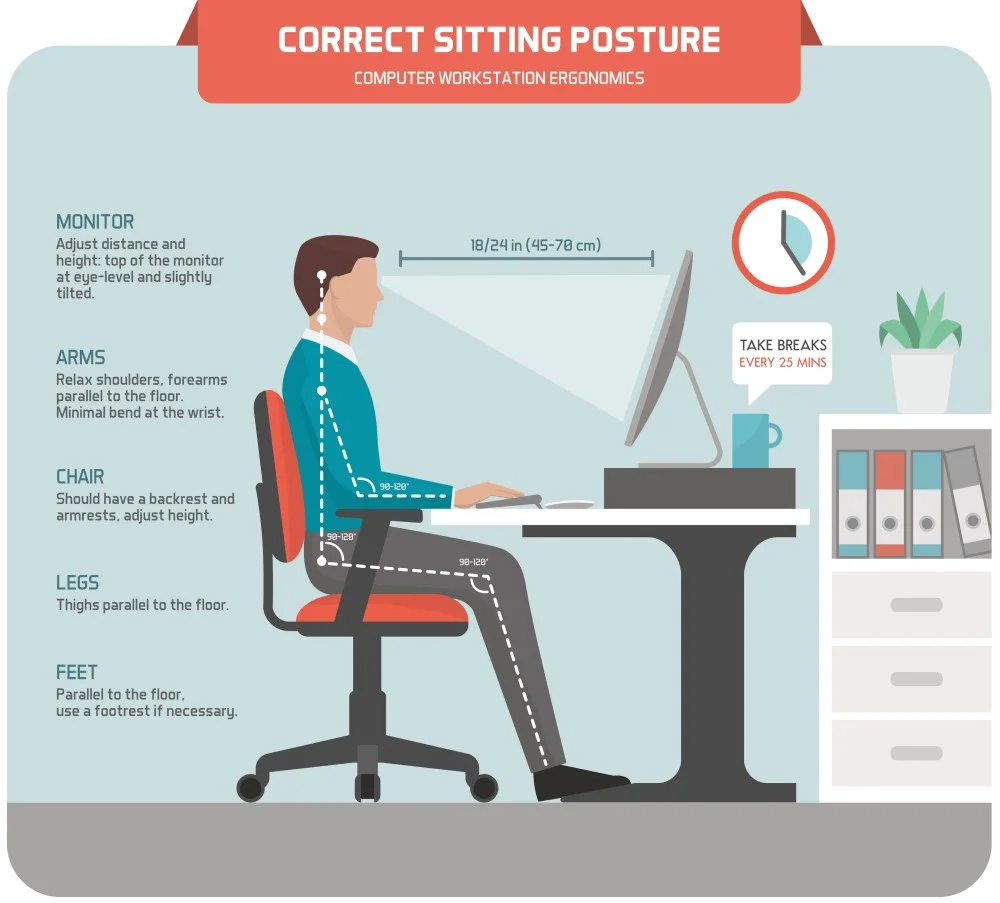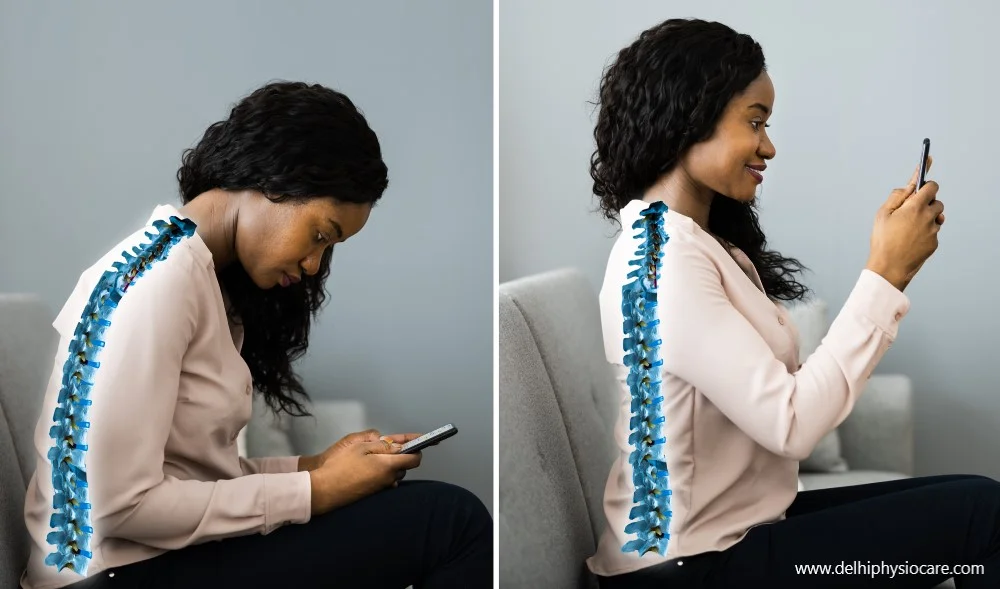Posture Correction
Home / Posture CorrectionPosture Correction

Correct posture is not only an important part of your personality, it also maintains your health by preventing pain and injuries.

Being in an uncomfortable position for a long time can affect your joints, muscles, tendons, ligaments, spine and even nerves. This can lead to localized, referred or radiating pains. It can also restrict the normal range of movement in a joint. Bad posture also starts effecting balance and coordination and increases the risk of falling.

There is a correct posture for all positions whether standing, sitting, lying or driving. So even while watching television, working in kitchen/office or going for a walk, be mindful of your posture. This is not as difficult as it sounds rather it becomes an important part of your lifestyle as you imbibe it.

There can be various reasons for bad posture;
There can be various reasons for bad posture;
- Joint stiffness [Ex. Stiff neck, Back, Knees].
- Lack of exercises [sedentary lifestyle].
- Weak muscles.
- Tight muscles [Lack of flexibility].
- Occupational hazard.
- Habit.
At Delhi Physio Care, we diagnose a lot of pains related to wrong postural habits. Majority are identified by a thorough assessment, which leads us to the cause. Postural re-education becomes an important part of the treatment.
Symptoms can be managed by;
- Pain relief modalities like US, IFT, TENS, Lasers, Hot / Cold packs.
- Joint mobilization.
- Soft tissue mobilization.
- Trigger point therapy.
- Taping.
Once the pain starts to subside, exercises are started for strengthening and flexibility. Gradually Therabands and Weights are also added.
Important Tips
We will now give you some important tips to remember for a correct posture in different positions.
SITTING

- Invest in a good chair. It should give a good back support with arm rest.
- While sitting your bottom should be completely touching the back of the chair.
- If needed can put a small cushion at the hollow of the back.
- Thighs and hips should be well supported on the chair.
- Hips and knees should be at about the same level.
- Height of the chair should be such that the feet touch the floor, if not use a footrest.
- Avoid sitting with one leg over the other.
- Distribute the body weight evenly on both hips.
- Shoulders should be back and relaxed.
- Ear and shoulders should be about the same level.
- Use an arm chair with elbows relaxed close to the body.
- Wrist neutral and not bent.(while working on the keypad to avoid carpal tunnel symptoms).
- The laptop screen should be at the eye level.( do not work on the system, sitting on the bed).
- If the chair has wheels, turn using complete body rather than just the waist movement with the chair turning.
- Take regular breaks from continuous sitting, say five to ten minutes after every half an hour. Stand, walk or just stretch in the break.
- Learn those exercises that can be done in sitting, that help in keeping your posture correct and keep the muscles flexible.

STANDING
- Being in one position for a long time effects our posture and can lead to pains. Get a good standing posture by practicing against a wall. Heels, buttocks, shoulders and head should be all in contact with the wall at the same time.
- Check yourself in the mirror. Your body should be in a straight line from ear- shoulder- hips.
- Stand tall with your spine straight.
- Keep your body weight on both legs. Do not stand with your weight on one leg. Shoulders should be pulled back. While lifting an object from the floor, move your feet apart.
Get closer to the object and bend your knees to go down. Never bend from your back to lift objects from the floor; it can lead to something as serious as a herniated disc.
LYING
- Invest in a good mattress. It should be firm and supporting the back well.
- The most suggested position is lying on your back with spine supported. Can use a pillow under the knees to reduce the curve of the lower spine.
- In side lying, keeping a pillow in between the knees also helps to support the spine. Avoid going in fetal position.
- Avoid sleeping on your stomach or in prone position. It is difficult to keep the neck supported in prone and can even aggravate the pain if any.
- Do not read or work on your laptop from bed. Do not read or watch television lying on your stomach. It might feel relaxing but it leads to increase in lumbar lordosis (aggravated lower spine curve). This leads to pains in lower back and glutes and alters the posture.
- When getting up from the bed, take a side turn, get the legs down first and then while putting the weight on the forearms and hand get up. This seems complicated but it actually takes the same amount of time that is taken while getting up straight. It is just a simple lifestyle modification that will take care of your spine.
DRIVING
- If suffering from back pains, avoid driving.
- Use a driver if possible. It is advisable to sit in the front seat next to the driver’s. Remember, front seats are always more comfortable than the back ones.
- When self-driving, keep your seat at about 100 degrees, supporting the back well. If needed keep a small cushion in the hollow of the lower back.
- Keep your seat close to the steering wheel. There is less strain to the back and knees then.
Some general tips that should be followed;
- EXERCISE to stay fit.
- Keep your body weight in check.
- Wear comfortable footwear.
Listen to your body. Do not ignore the pains.
GOOD POSTURE keeps you toned and makes you look taller and slimmer. It increases your confidence.
LOOK AND FEEL BETTER !!!
If you have pain/ache or struggle to maintain a balanced posture or if you would just like advice on posture or your workstation book an appointment to see one of our experienced & skilled physical therapists.
QUICK ENQUIRY
Send us a message with your contact details and one of our staff will contact you right away.
TREATMENTS
BOOK AN APPOINTMENT
GENERAL ENQUIRIES
235, Avtar Enclave,Paschim Vihar,Delhi – 110063
Posture Correction FAQ’s
A posture correction brace helps in improving the body posture. It is used by people with poor shoulder alignment. Posture braces are generally designed to be soft and comfortable.
Good posture is the proper alignment of your body when standing or sitting. Correct positioning involves training yourself to hold your body against gravity with the least strain and tension on supportive structures, such as your muscles and ligaments. Proper posture keeps your bones and joints in optimal alignment and decreases wear and tear on supportive structures.
Bad posture can be caused by a variety of factors, including being overweight, not exercising, and not practicing proper ergonomics while at work and home. We check your posture to determine if you need posture correction. If you do, our chiropractor will recommend a treatment program that may include adjustments and body exercise.
Practicing good posture can lower your back and neck pain. It can increase your confidence, reduce stress and help you improve your productivity at work. It may even boost your energy levels.
- The complications of poor posture include back pain, spinal dysfunction, joint degeneration, rounded shoulders, and a potbelly.
- To improve your posture include regular exercise and stretching, ergonomic furniture, and paying attention to the way your body feels.
Bad posture can lead to back and neck pain and increase your risk for spinal injuries. It can also decrease the efficiency of your circulatory system. When these symptoms are combined, you may have difficulty exercising or being active for extended periods due to muscle and joint pain. Posture correction at first Delhi physio care can help you achieve and maintain good posture so that you can feel better.
- Stand up straight and tall.
- Keep your shoulders back.
- Pull your stomach in.
- Put your weight mostly on the balls of your feet.
- Keep your head level.
- Let your arms hang down naturally at your sides.
- Keep your feet about shoulder-width apart.
